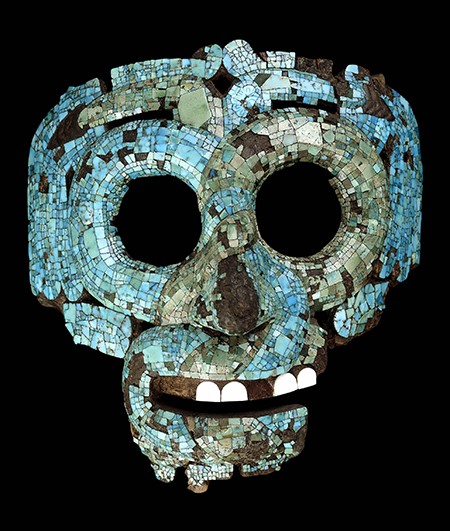Nahua artists working in central Mexico under the Aztec Empire (1428–1521) drew upon their intimate knowledge of material and form to create works that combined fine stones, precious metals, and rare feathers. By meticulously juxtaposing blue and green turquoise tesserae, forming ornaments cast in gold, and delicately layering luminous feather barbs, artists produced intensely sensorial works that were intended for use only by Nahua rulers, god representatives, warriors, and nobles. For Nahua people, works in these media were unified by shared aesthetics—including saturated coloration, silky surface texture, and high shine—and by their perceived ability to contain both extraordinary value and tonalli, an animating heat thought to derive from the sun. Such works represented an intersection of economic value, high aesthetics, intense sensory experience, and power.
Although works in these materials have long been studied as distinct artistic media, Nahua cultural practices and original writings in the Nahuatl language point to their conception as a unified form of production seen as the height of artistic achievement. As such, works in these media also represented a site for deep reflection by Nahuas upon the core issues that structured and motivated artistic practice. Collectively, artistic production with precious stones, metals, and feathers motivated a cultural discourse that critically examined the concepts of value, color, surface, and animacy and their roles in artistic practice. Integral to artists’ acts of judgment, these issues also interwove artistic expertise with other realms of knowledge, including philosophy and natural history.
Nahua people articulated this discourse both through their shaping of surviving works of art and through language, preserved in Nahuatl terminologies and written expressions. The combined study of details of facture and linguistic expression permits new insight into the major issues that critically shaped Nahua understandings of artistic work in valued media.
My dissertation examines Nahua theorizations and artistic employments of value, color, surface, and animacy. By analyzing Nahua approaches to materials—through linguistic expression and individual choices made by artists—I draw out the ways in which knowledge of the material world informed Nahua artistic practice and how artists themselves participated in knowledge production. Further, my project asks how Nahua articulations of major issues of artistic theory and practice generate new vantages for art-historical discussions.
Using Nahuatl writings and key works of art, my project explores how value, color, surface, and animacy were constructed and articulated in Nahuatl discourse and how individual artists engaged with these issues in their work with precious materials. The first chapter reconstructs Nahuatl discourses on recognizing valued materials within a larger ecosystem and examines how artists embodied knowledge of different aspects of value in their transformation of natural materials. The second chapter analyzes Nahuatl linguistic constructions of color (ixnezcayotl) and establishes that color was conceptualized as arising from relationships between material objects. I examine how the turquoise and shell tesserae of a mosaic mask in the British Museum, London, utilize the logic of such material relationships to represent other entities. The third chapter analyzes the Nahua concept of surface (ixtli) as an organ that enabled people and worked objects alike to possess form and thereby to present themselves socially and sensorially. Through a close reading of a Nahuatl narrative of the process of lost-wax gold casting, I draw out an understanding of this process as cultivating the work’s form and gradually implanting it in the cast work’s surface. The final chapter analyzes the role of tonalli, conceived as a form of animating heat derived from the sun, in motivating the physical structure and aesthetics of brilliance in layered feather mosaics, such as the coyote shield in the Weltmuseum Wien. The conclusion addresses the larger significance of understanding historic Nahua artistic practice and theory from the viewpoint of Nahuatl linguistic traditions and individual practices of art-making.
Ultimately, this project makes visible the forms of knowledge exercised in the creation of Nahua art in precious media and reinserts such works into the larger bodies of knowledge in which they participated. By integrating linguistic and material-based studies, I present understandings rooted in Nahua cultural concepts of key works of art and bring Nahua thinking into conversation with larger scholarly discussions of artistic theory and practice.
